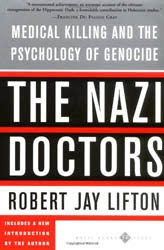 There is an interesting discussion underway in the thread from a previous post between two valued SHS commenters, as to whether the Dutch infanticide that has flowed illegally, but generally undisturbed. from the country’s euthanasia permissiveness, can be fairly compared to the infanticide of disabled infants during the medical Holocaust in Germany during World War II. One commenter said, appropriately, that we should be very careful before drawing such analogies. The other, who is reading Robert Jay Lifton’s magnificently researched The Nazi Doctors, sees striking similarities and is disturbed.
There is an interesting discussion underway in the thread from a previous post between two valued SHS commenters, as to whether the Dutch infanticide that has flowed illegally, but generally undisturbed. from the country’s euthanasia permissiveness, can be fairly compared to the infanticide of disabled infants during the medical Holocaust in Germany during World War II. One commenter said, appropriately, that we should be very careful before drawing such analogies. The other, who is reading Robert Jay Lifton’s magnificently researched The Nazi Doctors, sees striking similarities and is disturbed.
I think both are right. There are some similarities between what is happening in the Netherlands now, and what happened in Germany then. But there are also pronounced differences. In fact, I spent quite a bit of time on this subject in both Forced Exit and Culture of Death.
First, let’s start with the significant differences:
- It is indisputable that the leaders of the Netherlands are not Nazis and the Dutch people have not swallowed the poisonous ideology of fascism, totalitarianism, and racial hygiene.
- In their permissive attitude toward infanticide, the Dutch are not engaged in a specifically eugenic enterprise, that is, the infanticide isn’t about cleansing the race or improving the human “gene plasm.”
- The Dutch do not, as did the German government under Hitler, require midwives and doctors to report every child born with disabilities, in order to keep track of all for potential killing regardless of how mild the impairment. The babies killed in the Netherlands are all either terminally ill or have very serious disabilities.
- German doctors killed tens of thousands of disabled babies. Two Lancet studies showed that about 8% of all infants who die in the Netherlands are killed by doctors, amounting to about 80-90 per year.
- In Germany, the infanticide policy was based on a secret edict issued by Hitler right after the beginning of World War II and doctors were under no legal threat for participating. In the Netherlands, infanticide remains, technically, murder under the law, even though physicians are rarely prosecuted and in the few cases in which they are, face only minor and entirely symbolic sanction.
But these real and substantial differences should not make us sanguine. I strongly recommend all who are interested in this topic read The Nazi Doctors by Lifton and Death and Deliverance by Burleigh, the two best books on this topic. If you do, you will see that:
- The act of infanticide is the same—babies are being killed by doctors.
- The focus on “quality of life” is also similar, (although far fewer babies “qualify” for being killed). Germans called it “life unworthy of life,” or “useless eaters,” while the Dutch call it an “unliveable life.”
- The German program was not driven by Nazis but by doctors—as in the Netherlands—who called infanticide a “healing treatment,” thought to be best for the baby, the family, and the Reich. In the Netherlands, infanticide is deemed a compassionate act done for the baby.
- It is true that in most cases, Dutch babies are killed with the knowledge of their parents—not that parents should be able to consent to murder—but according to a study in the Lancet, 27% of infanticides in the Netherlands are done without parental knowledge or consent.
And then there is this: The history of the first baby killed in the medical Holocaust, is eerily similar to what happens in the Netherlands—and what bioethicists like Peter Singer advocate. From my book Culture of Death:
The first known German government-approved infanticide, the killing of Baby Knauer, occurred in early 1939. The baby was blind and had a leg and an arm missing. Baby Knauer’s father was distraught at having a disabled child. So, he wrote to Chancellor Hitler requesting permission to have the infant “put to sleep.” Hitler had been receiving many such requests from German parents of disabled babies over several years and had been waiting for just the right opportunity to launch his euthanasia plans. The Knauer case seemed the perfect test case. He sent one of his personal physicians, Karl Rudolph Brandt, to investigate. Brandt’s instructions were to verify the facts, and if the child was disabled as described in the father’s letter, he was to assure the infant’s doctors that they could kill the child without legal consequence. With the Fuhrer’s assurance, Baby Knauer’s doctors willingly murdered their patient at the request of his father. Brandt witnessed the baby’s killing and reported back to Hitler who was pleased all went as planned. Based on this case of requested infanticide, Hitler signed the order permitting doctors to kill disabled infants.[i]
[i] Lifton, Nazi Doctors, Supra., p. 51.
So, while the Nazi analogy should be used with great restraint, and differences should be noted, the charge that Dutch infanticide has certain very disturbing similarities cannot be rejected out of hand. Indeed, in the concept of the life deemed so compromised that it justifies killing, we see disturbing echoes from history that should give us all great pause.



